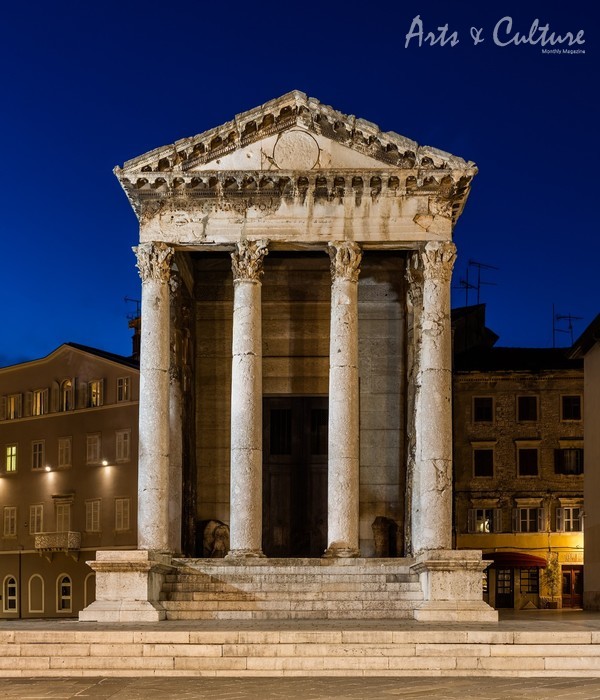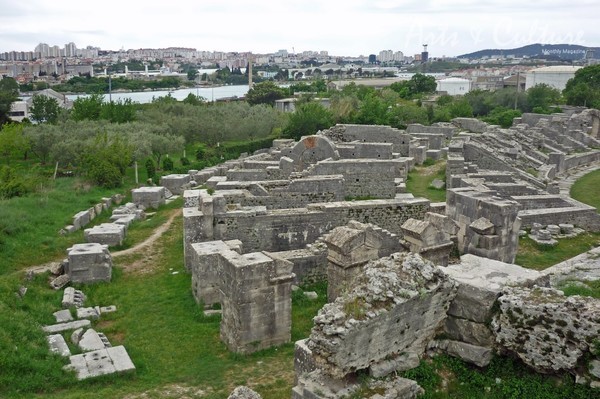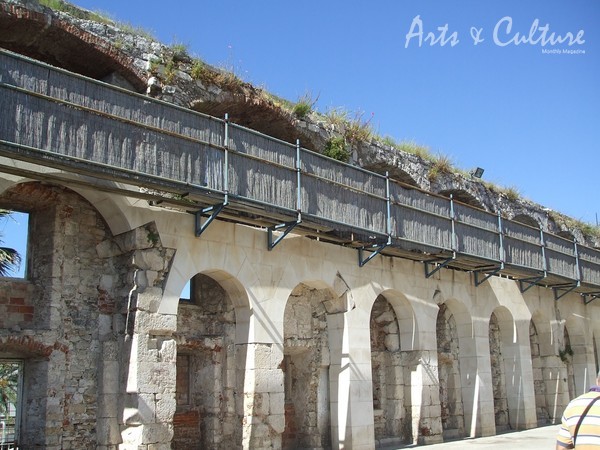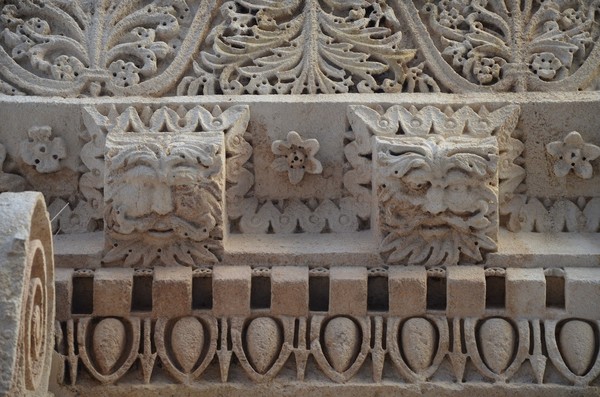
크로아티아에서 커피를 마시며 행복한 여유를 즐기다 보면, 미처 인식하지 못했던 멋진 장관이 눈앞에 불쑥 펼쳐지는 놀라운 경험을 한 적이 많다. 최근 크로아티아 해안도시 풀라의 중앙 광장에서 향기로운 카푸치노를 마실 때도 그러했다. 이스트리아의 아름다운 날씨를 즐기는 동안, 필자는 1세기에 지어진 보석 같은 건축인 아우구스투스 사원에서 불과 몇 걸음 떨어져 있지 않음을 직감했다.
아우구스투스는 로마의 첫 번째 황제이자 위대한 통치자 중 하나로 기원전 31년 마크 안토니우스와 함께 이집트 함대와의 전쟁에서 성공적인 승리를 이끌었으며 이집트, 중동의 주요 지역, 스페인 일부 및 중부 유럽을 합병하여 영토를 대 확장했다. 아우구스투스의 이러한 전투 기량과 전략적 정치가 알려진 것에 비하면 조세 제도, 인구 조사, 우편 서비스 도입과 경찰, 소방대의 제도화로 법과 질서를 확보한 업적은 잘 알려져 있지 않다.
기원전 25~20년에 도시 풀라에 지어 그에게 헌정된 이 사원은 수 세기 동안의 전쟁, 소요 및 화재를 거치면서도 건축 유산으로 잘 보존되어, 법과 질서가 우리 문명이 번성하는 데 어떻게 도움을 주는지를 잘 보여준다.

모퉁이를 도니 완벽하게 보존된 로마 원형극장 풀라 아레나다. 건축을 전공한 필자는 1세기에 건축되어 2,000년이 넘게 보존된 석회암으로 만들어진 132mx105m 타원형 구조의 이 건축물에 깊은 인상을 받았다. 32m 높이의 벽이 하단 두 개 층에 72개의 원형 아치, 상단에 64개의 직사각형 개구부로 디자인되어 검투사 경기 관람에 23,000명 이상의 관중을 수용할 수 있었다. 오늘날 풀라 관광청은 그 엄청난 잠재력을 인식하고 정기적 관광상품으로 전통 복장의 검투사 경기를 해마다 재연하고 있다.
또한 오페라, 클래식 콘서트, 발레, 록 콘서트 및 대중음악 등 전 세계의 음악 및 문화 공연에 매우 인기 있는 곳인데 아직 K-Pop 아티스트의 공연이 없었다고 하니 조금 아쉬웠다. 이 역사적인 장소에서 한국인의 공연도 조만간 열리게 되기를 바라본다.
고대로마 유적지가 크로아티아 아드리아 해안 전역에 널리 퍼져 있지만 우리에게는 생소한 편이다. 4세기 초 로마 황제 디오클레티아누스가 스플리트에 건축한 궁전과 제우스 신전 건축 단지는 후에 건축사에서 ‘아담 스타일’로 알려진 운동 이론의 창시자인 유명한 18세기 스코틀랜드 건축가 로버트 아담에게 영감을 주었고, 그는 이 건축물들이 유럽에서 가장 경이롭고 아름다운 건축물 중 하나라고 예찬한 바 있다.

달마티아 지방의 고대로마 수도이자 디오클레티아누스 출생지였던 고대로마의 도시 살로나 역시 역사적으로 가치 있는 유명한 발굴지 중 하나로 관광객뿐만 아니라 고대 건축 양식과 건설 기술에 관심이 있는 고고학자와 건축가에게도 매력적인 장소로 꼽힌다. 이 도시는 원래 기원전 10세기에 고대 그리스 시장으로 세워졌으나 로마의 황금시대에는 60,000명이 살던 큰 도시로 발전하여 아름다운 대형 궁전, 원형극장, 포럼, 공중목욕탕 또는 온천 및 수로와 같이 모든 도시 요소를 갖추고 있었다.
특히, 고도로 정교하게 만들어진 수로에 13m 높이 차이를 두어 9km 떨어진 강으로부터 살로나와 디오클레티아누스 궁전으로 물을 끌어오도록 한 기술은 정말 놀랍다. 도시는 길이 약 4km, 폭 약 2m의 성벽으로 둘러싸여 있으며 최소 90개의 탑으로 요새화되었다.

크로아티아의 건물들을 보고 있노라면 마치 건축사 대부분의 양식을 훑어보는 유럽 건축사의 교과서를 보는 듯하다. 크로아티아는 역사 속에서 끊임없이 고통을 겪었으나 그만큼 노련하게 이겨내며 보석 같은 문화유산들을 잘 보존해왔다. 낮은 인구 밀도, 우수한 공중 보건 및 예방 조치를 통해 크로아티아는 코로나 전염병 시대에도 전 세계 수백만 명의 외국인 관광객에게 절실히 필요한 여름 휴가를 즐기도록 문을 활짝 열어 주었다.
안전한 여행지로 우리에게 다가온 휴양 천국, 고마워, 크로아티아!
JEWELS OF FIRST-CENTURIES ROMAN ARCHITECTURE IN CROATIA
One thing about Croatia that never fails to amaze me is the seemingly benign idea of just sipping a coffee but being met with a truly remarkable view. Recently, the tasty cappuccino I had on the city square of the Croatian coastline city of Pula was no exception. While enjoying the beautiful Istrian weather, it occurred to me that I was sitting just a few meters away from Augustus’ Temple, a magnificent architectural jewel built in the first century, during the Roman Emperor Augustus. Caesar Augustus was both Rome’s first Emperor and one of its most successful rulers, managing to restore peace, prosperity, and improve the quality of life across the Empire.
Acclaimed as a hero after his successful victory over Mark Anthony and the Egyptian fleet in 31. B.C., he immensely expanded Roman territories, annexing Egypt, significant parts of the Middle East, parts of Spain and Central Europe. Apart from his battle prowess and strategic politics, a lesser known fact is that he introduced the taxation system, the census, and the postal service, as well as institutionalized the police and fire-brigade, securing law and order.
Just around the corner lays another heritage jewel from the first century: the equally preserved Roman Amphitheatre known as the Pula Arena. It is among the few preserved Roman amphitheaters that exist. As an architect myself, I was thoroughly impressed by the 132m x 105m oval structure made of limestone, with 32m high walls, 72 circular arches lining the first two floors and 64 rectangular ones across the top. During Ancient Roman times, the Arena housed more than 23,000 spectators for gladiator games and tournaments. Today, the local tourist industry has recognized its magnificent potential and regularly organizes re-enactments of gladiator games in full costume as a top tourist attraction.
The Arena is also a highly popular place for music and cultural performances from all over the world, including operas, Classical music concerts, ballets, rock concerts and popular music. I was only a bit disappointed to learn that there have been no K-Pop artists among this lengthy list of world-famous musicians.

Ancient Roman heritage sites are widely present throughout the Croatian Adriatic coast. Famously, Split is the home of the UNESCO-protected Diocletian’s Palace, built by the Roman Emperor Diocletian at the turn of the 4th century. The architectural complex of Diocletian’s Palace and the Temple of Jupiter also inspired the famous 18th century Scottish architect, Robert Adam, who considered them one of the most beautiful architectural wonders in Europe and was later the founder of the “movement theory” in architecture, later known as Adam’s Style.
Near Diocletian’s Palace is one of the most prominent excavation sites of the ancient Roman city of Salona, which was the ancient Roman capital of the Province of Dalmatia and Diocletian’s birthplace. The city was originally established as an ancient Greek marketplace in the 10th Century B.C. During the Golden Age of Rome, the city had 60,000 inhabitants, making it one of the larger ones. The ruins of the city are an attraction not only to thousands of tourists and visitors, but also to archeologists and architects interested in ancient building styles and techniques.

Salona housed all the urban elements expected of Roman cities: the beautiful large palaces, the amphitheater, the forum, public baths or thermae, and the aqueduct. This traditional, highly sophisticated Roman aqueduct, with a height difference of 13m, brought water from the 9km distant river to both Salona and to Diocletian’s Palace. The city was encircled by walls of some 4km long, approximately 2m wide, and fortified with at least 90 towers.
Leafing through the sizeable book about architectural history of Croatia, one notices that it seems qualified to act as a textbook for all European architectural history, with a visible presence of most styles. Akin to throughout its history, Croatia continues to skillfully navigate through times of trouble and preserve its rich cultural heritage. With a very low population density, good public health, as well as a responsible approach and preventative measures, Croatia once again, even in the times of the corona-pandemics, has opened its doors to millions of foreign tourists from around the world, to enjoy their much-needed summer holidays this year. It approved to be a safe destination. Thank you, Croatia.
글 | 순영 레든 Soonyoung Redden
건축학 석사( 홍익대), 한.크로아티아 협회 사무총장, 크로아티아 문화 여행 전문가

